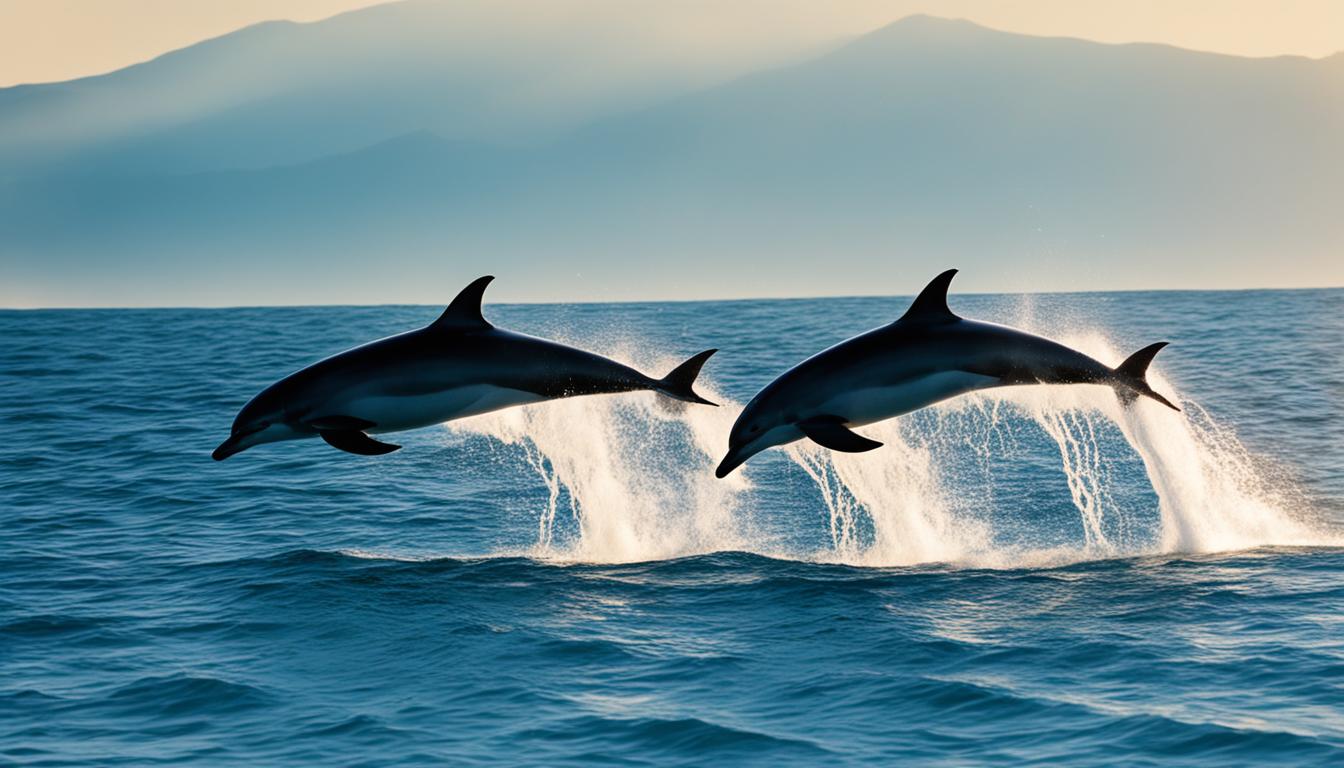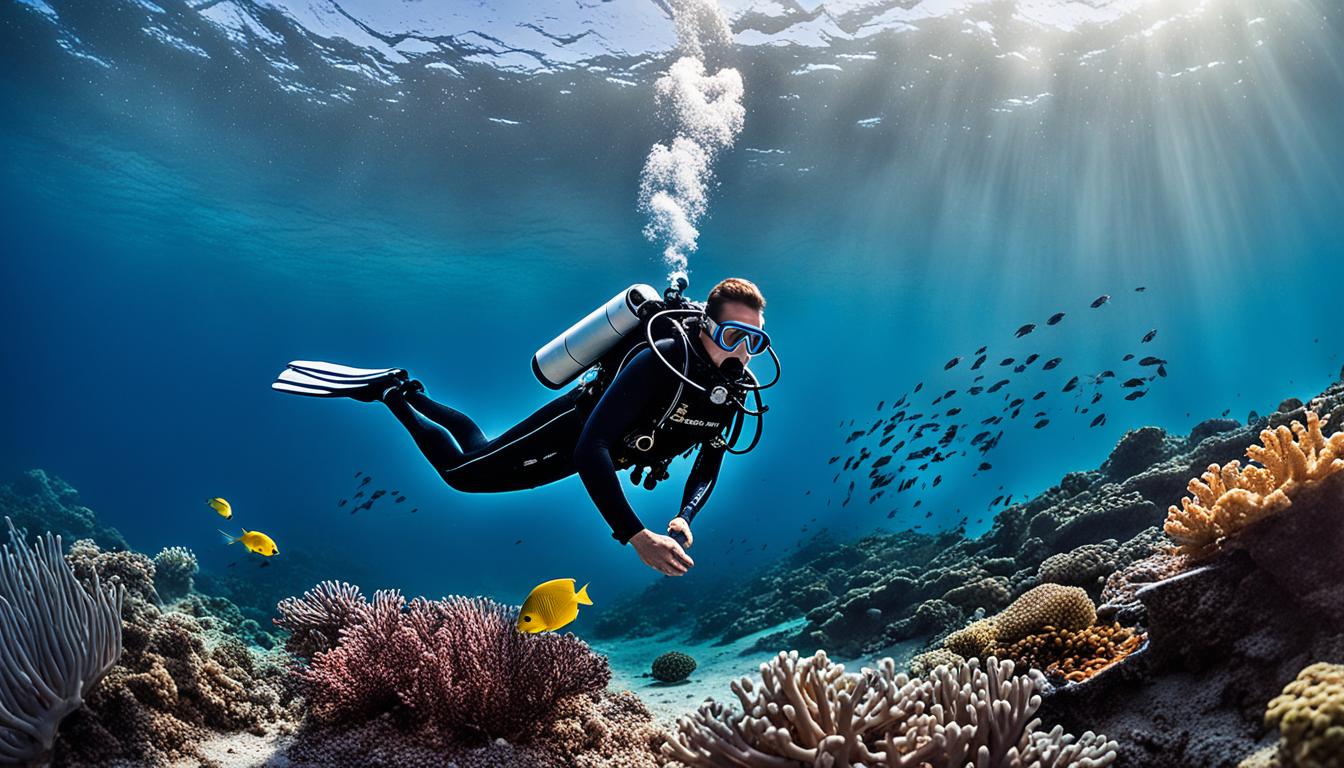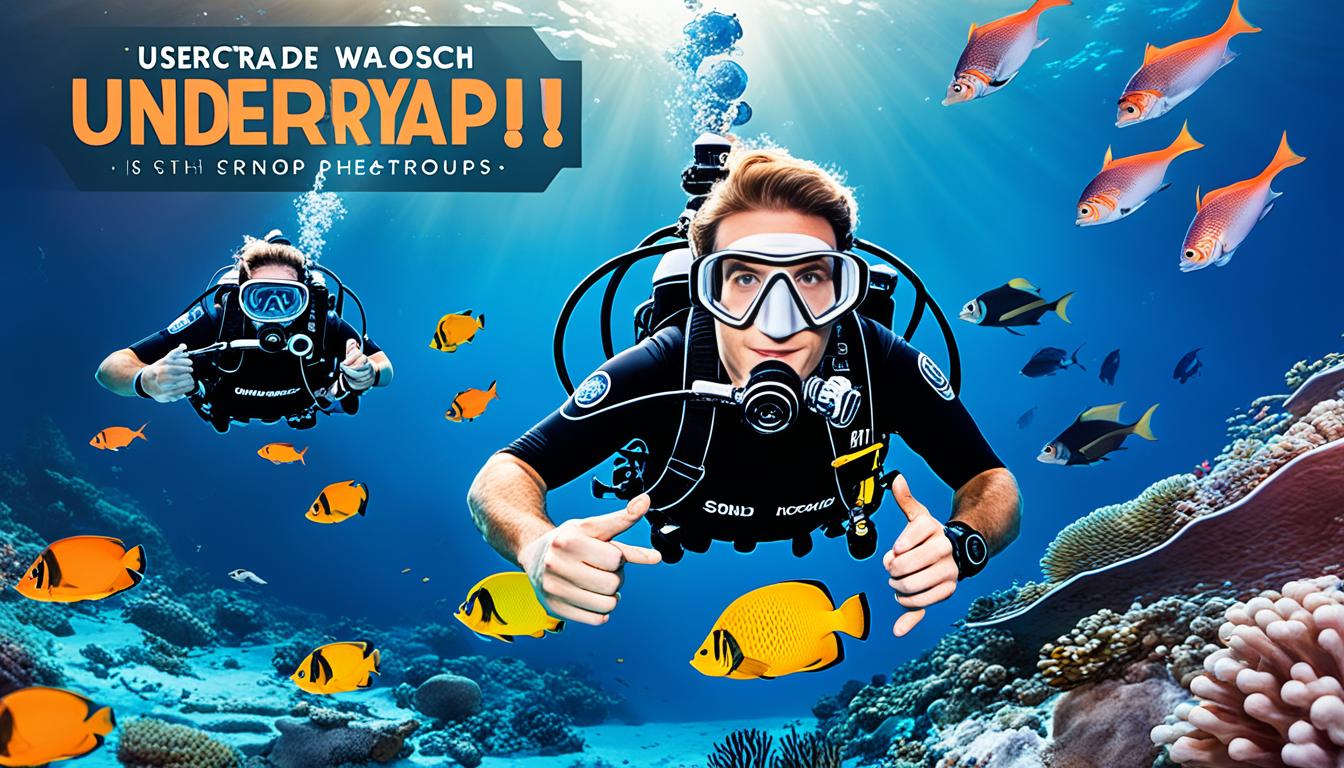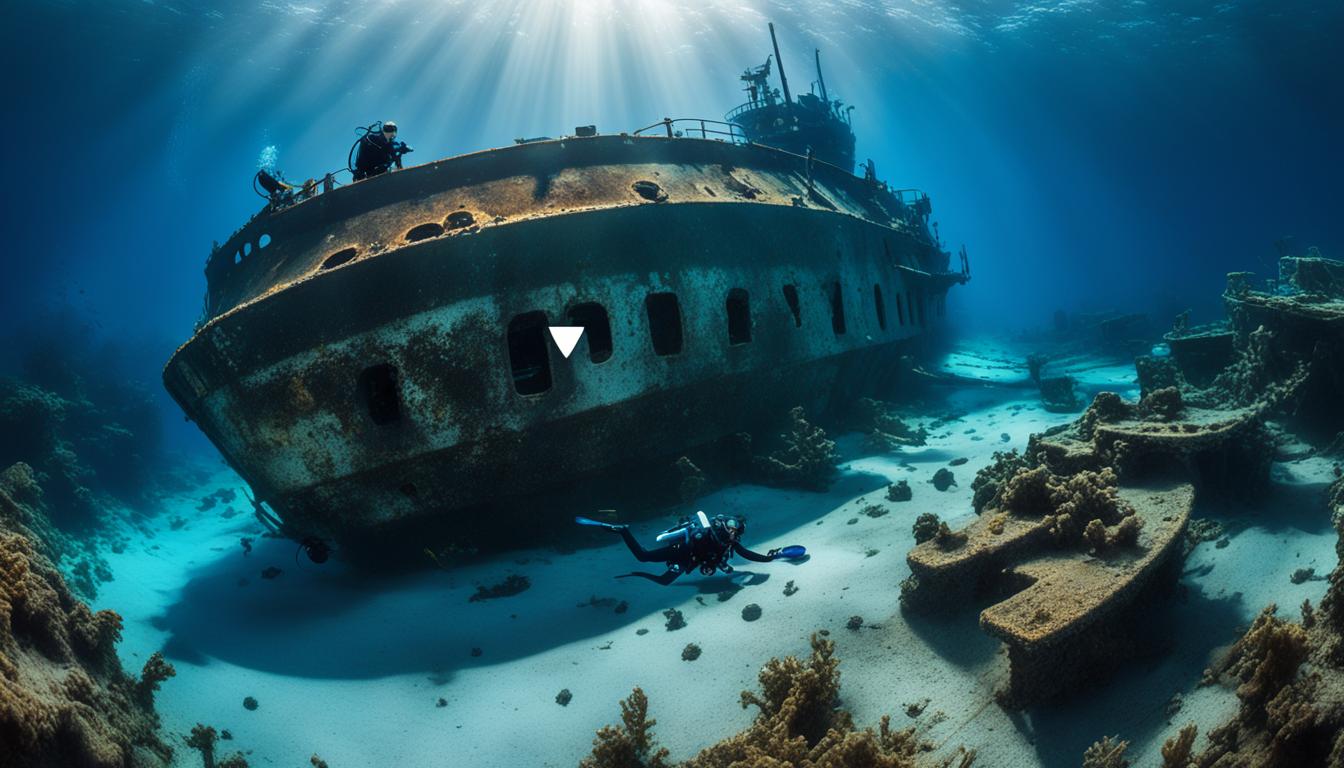Underwater photographers have a unique opportunity to explore the captivating world of marine wildlife behavior through their lenses. By immersing ourselves in the depths of the ocean, we can capture breathtaking moments that showcase the natural behaviors of marine animals. In this article, we will delve into the art of marine animal behavior photography and share valuable tips for capturing these remarkable moments.
Key Takeaways:
- Underwater photographers can showcase the beauty and complexity of marine wildlife behavior through their images.
- Patience, observation, and understanding of marine life are crucial for successful behavior photography.
- Ethical wildlife photography techniques and best practices are essential for capturing behavior without disrupting natural patterns of life.
- Thorough research on dive sites and local knowledge can help identify locations that offer great opportunities for behavior photography.
- Choosing the right photography gear and setting up strobes properly can enhance the capture of decisive moments.
Understanding Behavior Photography
Behavior photography is a fascinating and challenging pursuit that requires a unique set of skills. As photographers, it is our responsibility to approach this art form with respect for the subjects and their natural patterns of life. By understanding ethical wildlife photography techniques and best practices for photographing marine animals, we can capture behavior in a way that promotes awareness and empathy.
In behavior photography, our goal is not simply to record what is happening but to tell a visual story. This requires us to go beyond surface-level observations and delve deeper into the behaviors of different species. By building knowledge about marine animals and their unique behavioral characteristics, we can anticipate and capture decisive moments that convey the essence of their actions.
One of the key aspects of ethical behavior photography is ensuring that the subjects are not disturbed or harmed in any way. We must approach them with respect, allowing them to carry on with their natural behaviors undisturbed. This involves maintaining a safe distance, avoiding sudden movements, and using strategies that minimize our impact on their environment.
By following these ethical guidelines, we can build trust with the marine animals we photograph, enabling us to capture their behaviors authentically. Our images become a powerful medium for raising awareness about the wonders of marine life and the importance of conservation.
Spotting and Anticipating Behaviors
Spotting and anticipating behaviors is an essential skill for behavior photographers. It requires a keen eye for detail and a deep understanding of the species we are photographing. By observing the surrounding environment and paying close attention to subtle cues, we can anticipate when a behavior is about to occur and be ready to capture it.
For example, if we are photographing a group of dolphins, we may notice changes in their body language or the way they interact with one another. These subtle signs can indicate that a particular behavior, such as breaching or feeding, is about to take place. By being patient and observant, we can position ourselves in the right place and be ready to press the shutter at the perfect moment.
Creating Impactful Images
Creating visually impactful images is a crucial aspect of behavior photography. We want our photographs to not only document the behavior but also evoke emotion and tell a story. Composition, timing, and lighting all play critical roles in achieving this goal.
When it comes to composition, we should strive to create a visually pleasing frame that guides the viewer’s eye towards the subject and conveys the essence of the behavior. Framing the subject in a way that complements its surroundings can enhance the narrative and create a more immersive experience for the viewer.
The timing of the shot is also crucial. Capturing the peak of the action or the exact moment when the behavior occurs can add drama and intrigue to the image. This requires patience and practice, as well as a thorough understanding of the behavior and the species involved.
Lastly, lighting plays a significant role in behavior photography. Underwater environments can present unique challenges when it comes to controlling the light. By mastering techniques such as using artificial lighting or working with natural light in creative ways, we can enhance the visual impact of our images, highlighting the behavior and adding depth and dimension to the composition.
| Key Tips for Ethical Behavior Photography |
|---|
| Approach subjects with respect and without disrupting their natural behavior |
| Build knowledge about different species and their behaviors |
| Anticipate and observe subtle cues to spot behaviors before they happen |
| Create visually impactful images through thoughtful composition |
| Capture the peak of the action to tell a compelling story |
| Master lighting techniques to enhance the visual impact of images |
Tips for Photographing Marine Wildlife Behavior
Capturing the fascinating behavior of marine wildlife through photography requires careful planning and the right equipment. To help you make the most of your underwater adventures, we’ve compiled some valuable tips and insights to enhance your marine wildlife behavior photography.
Research Dive Locations
To capture marine wildlife behavior effectively, it’s crucial to conduct thorough research on the best dive locations. Seek local knowledge or consult experienced divers to find prime spots that offer great opportunities for behavior photography. Look for areas with cleaning stations, where marine animals gather to have parasites removed, or areas with high marine life density. These locations provide excellent chances to witness and document captivating behavior moments.
Choose the Right Photography Gear
Investing in the right photography gear is essential for capturing marine wildlife behavior in all its glory. Here are some equipment considerations:
- Underwater Camera: Use a reliable underwater camera that offers high resolution and fast autofocus to capture clear and vibrant images. Popular brands like Nikon and Canon offer excellent options specifically designed for underwater photography.
- Lenses: Select appropriate lenses that allow you to capture the desired behavior from a safe distance. Wide-angle lenses are perfect for capturing expansive behavior moments, while macro lenses enable you to focus on intricate details.
- Strobes and Lighting: Proper lighting is crucial in underwater photography. Invest in quality underwater strobes to illuminate your subjects and enhance the details of the behavior being captured.
Master Strobe Setup
Setting up your strobes properly can greatly enhance the capture of decisive moments. Experiment with different positioning and angles to achieve optimal lighting conditions. Avoid harsh shadows by diffusing the strobe’s light using specialized diffusers or reflective surfaces. This will help create stunning and well-lit images that showcase the behavior in its true essence.
Be Patient and Prepare for the Unexpected
Patience is key in behavior photography. Some behaviors may occur spontaneously, while others may require hours of observation. Be prepared to spend time waiting for the perfect moment to unfold. Pre-focus your camera on an area where the behavior is likely to occur, so you can quickly capture the action when it happens. Remember, the underwater world is full of surprises, so always be ready for unexpected and unique behavior moments.
By following these tips and armed with the right knowledge and equipment, you’ll have a better chance of capturing incredible marine wildlife behavior. Remember, ethical behavior photography respects the animals and their environment, ensuring that their natural behavior remains undisturbed. Now, let’s dive into the amazing world of marine wildlife behavior photography!

Examples of Marine Life Behavior
When it comes to capturing wildlife moments through marine animal behavior photography, there is no shortage of fascinating subjects to explore. The diverse behaviors exhibited by marine life offer unique opportunities to capture captivating and informative images. From predation to mating rituals, each behavior tells a story and provides a window into the underwater world.
Predation
One of the most thrilling behaviors to witness and photograph is predation. Whether it’s a shark hunting its prey or a sea lion diving for fish, the intensity and speed of these moments can be breathtaking. Capturing the perfect shot requires a keen eye and quick reflexes, as predation happens in the blink of an eye.
Feeding
Feeding behaviors vary greatly among marine animals, from filter-feeding whales engulfing tons of krill to tiny shrimp meticulously picking at coral polyps. Documenting these feeding behaviors not only showcases the diversity of marine life diets but also highlights the delicate balance of ecosystems.
Underwater Cleaning Stations
Some marine animals, such as reef fish and mantas, visit cleaning stations where smaller reef creatures remove parasites and dead skin. Observing and photographing these interactions provides insight into the symbiotic relationships that exist on coral reefs and allows us to appreciate the importance of maintaining healthy reef ecosystems.
Marine Life Reproduction
The reproductive behaviors of marine life are both fascinating and essential for the survival of species. From fish carrying eggs in their mouths to marine mammals nurturing their young, documenting these moments brings awareness to the intricate life cycles of marine animals.
Interactions and Communication
Marine animals use various forms of communication to interact with each other. Fish fighting for territory, mimicking behaviors to deceive predators, and flashing and warning displays are just a few examples of how marine creatures communicate. Capturing these behaviors helps us understand the complex social dynamics within underwater communities.
Curious Behaviors
Marine life is full of surprises, and sometimes animals exhibit behaviors that leave us with more questions than answers. Yawning fish, for example, may seem simple, but their yawning behavior is still not fully understood. These curious moments remind us of the mysteries that lie beneath the surface and inspire further exploration.
“Every behavior offers a unique opportunity to capture a moment that educates, inspires, and promotes the importance of marine conservation. Through our lenses, we become storytellers, sharing the wonders of marine life with the world.” – Team SeaCapture
Whether it’s witnessing the raw power of predation or observing the intricate communication between marine animals, capturing these wildlife moments through behavior photography allows us to appreciate the beauty and complexity of the underwater world. These images serve as a powerful tool to raise awareness about marine conservation and remind us of the fragile balance we must maintain in order to protect our oceans.
Continue reading to discover diving techniques for behavior photography and how composition and timing play a crucial role in creating extraordinary underwater images.
Diving Techniques for Behavior Photography
When it comes to capturing the captivating behavior of marine wildlife, diving techniques play a crucial role. By utilizing the right approaches and maintaining a respectful and unobtrusive presence underwater, photographers can witness natural behaviors and create stunning images that showcase the wonders of the underwater world.
Here are some essential diving techniques that can enhance your underwater wildlife photography:
- Dive Smoothly and Slowly: By moving through the water with smooth, controlled movements, you can minimize disturbances and ensure that marine life remains undisturbed. This allows you to observe and photograph behaviors in their natural state.
- Paying Attention to Dive Guides: Local dive guides are invaluable resources who can provide insights into the behavior and habits of marine creatures in specific areas. They can guide you to the best spots for behavior photography and help you make the most of your underwater adventure.
- Stay Low and Move Slowly: Keeping a low profile and moving slowly underwater allows you to approach subjects without alarming them. This increases your chances of witnessing behavior and capturing stunning images.
- Control Breathing: Regulating your breath helps to minimize bubbles and noise, ensuring a more peaceful and uninterrupted underwater environment. This can prevent disturbance to marine wildlife and enable you to observe behaviors without causing disruption.
In addition to these techniques, using a red light for stealth can be beneficial during night dives, as many marine creatures are less sensitive to red light. This can allow you to approach and photograph nocturnal behaviors without causing disturbance.
Now, let’s consider the importance of avoiding excessive bubbles in behavior photography:
“Excessive bubbles can startle marine creatures and disrupt their natural behavior patterns. By controlling your buoyancy and adjusting your finning technique, you can minimize the production of bubbles and create a more serene environment for observation and photography.”
By employing these diving techniques, photographers can approach marine wildlife with respect and capture their behaviors ethically. Remember, it’s our responsibility to preserve and protect these incredible creatures and their habitats.
Now, let’s take a look at how composition and timing play essential roles in behavior photography, creating visually stunning and impactful images that tell the story of marine life.

Composition and Timing in Behavior Photography
When it comes to behavior photography, composition and timing are essential elements that can make or break a shot. As photographers, we strive to capture those extraordinary moments in the natural world that tell a story and evoke emotions in viewers. In this section, we will explore the best practices for capturing wildlife moments and photographing marine animals.
Composition: Filling the Frame
In behavior photography, it is crucial to compose the frame in a way that showcases the subject while considering the surrounding elements. By filling the frame with the subject, you can create a visually impactful image that draws attention to the behavior you are capturing. However, it’s important to be mindful of not amputating important elements that provide context and contribute to the overall story.
“Photography is all about finding beauty in the details, and by composing the frame thoughtfully, you can highlight the intricate behaviors of marine animals.”
When composing the frame, consider the rule of thirds or use leading lines to guide the viewer’s eye towards the main subject. This can add depth and visual interest to your photographs, enhancing the overall composition.
Timing: Capturing the Peak of Action
In behavior photography, timing is everything. It is the art of capturing that split-second moment when the action reaches its peak, telling a compelling story within a single image. To achieve this, it is essential to have a deep understanding of the behavior you are photographing and anticipate the decisive moment.
Being in the right place at the right time is key. Observation and patience play a crucial role in behavior photography. By studying the subject beforehand and observing their patterns and cues, you can increase your chances of capturing those extraordinary moments.
“Timing is the difference between capturing an ordinary image and creating something truly extraordinary.”
Utilizing burst mode or continuous shooting can also help increase your chances of capturing the perfect moment. By taking a series of rapid-fire shots, you can select the frame that best encapsulates the behavior and conveys the intended message.
In the image above, we can see a perfect example of composition and timing in behavior photography. The image captures the moment a dolphin leaps gracefully out of the water, perfectly filling the frame and showcasing the peak of its action.
By focusing on composition and timing, photographers can create extraordinary images that capture the essence of marine animal behavior. These two elements, when combined with a deep understanding of the behavior being observed, allow us to tell captivating stories through our photographs.
The Beauty and Importance of Behavior Photography
Behavior photography is not just about capturing visually stunning images, but it also plays a crucial role in our understanding of marine life. Through their lenses, photographers can document and showcase behaviors that are rarely seen or studied, providing valuable insights to scientists and researchers. These images raise awareness about the intricacies of marine wildlife and foster a deeper connection between viewers and the natural world.
One of the core principles of behavior photography is ethical wildlife photography techniques. By adopting these techniques, photographers can ensure that their presence does not disrupt the natural patterns of marine life. This approach allows for the authentic portrayal of behaviors, capturing the true essence of life underwater. Ethical behavior photography also encourages empathy and a desire to protect our oceans, as viewers witness the beauty and vulnerability of marine wildlife firsthand.
Through the lens of a behavior photographer, we gain a new perspective on the diversity of marine life and the intricate interactions that take place beneath the surface. Each photograph tells a story, presenting rare moments and behaviors that evoke awe and curiosity. These images have the power to captivate audiences and inspire them to learn more about the marine environment and the need for its conservation.
“The more we understand about marine wildlife behavior, the better equipped we are to protect and conserve our oceans.” – Jane Goodall
Behavior photography not only contributes to scientific knowledge but also serves as a bridge between the scientific community and the general public. By sharing these images, photographers help to educate and raise awareness about the importance of marine conservation. They create a visual representation of the challenges faced by marine life, encouraging individuals and organizations to take action and support initiatives that protect our oceans.
As behavior photographers, our role extends beyond the art of capturing stunning images. We have the power to shape perceptions, challenge preconceptions, and inspire change. By using ethical wildlife photography techniques and showcasing the beauty of marine wildlife behavior, we become advocates for the oceans, striving to create a world where marine life thrives and future generations can continue to be captivated by its wonders.
| Benefits of Behavior Photography | Importance |
|---|---|
| Raises awareness about marine wildlife behavior | Increases public support for conservation efforts |
| Provides valuable insights to scientists | Contributes to scientific research and understanding |
| Educates the public about the intricacies of marine life | Promotes empathy and a desire to protect marine environments |
| Contributes to the documentation of rarely seen behaviors | Expands our knowledge of marine wildlife |
Conclusion
Marine wildlife photography is a captivating and meaningful pursuit that allows us to delve into the wonders of the underwater world. By employing ethical wildlife photography techniques, we can capture the essence of marine life while respecting the natural behaviors and habitats of these magnificent creatures.
Through our lens, we have the power to transport viewers to the depths of the ocean, conveying the beauty and complexity of marine wildlife behavior. Each image tells a story, igniting curiosity and fostering a deeper appreciation for these remarkable animals.
As photographers, we play a vital role in inspiring conservation efforts and raising awareness about the importance of protecting our oceans. By showcasing the captivating moments we capture, we can captivate audiences and instill a sense of responsibility to conserve and preserve these fragile ecosystems for future generations.
Let us continue to approach marine wildlife photography with respect, knowledge, and patience, and through our images, let us amplify the voices of the creatures beneath the waves. Together, we can make a difference and create a lasting impact on the preservation and appreciation of our marine world.
FAQ
What is behavior photography in marine wildlife?
Behavior photography in marine wildlife focuses on capturing natural behaviors of marine animals underwater. It aims to visually showcase the complexity and beauty of their actions and interactions.
What skills are important for successful behavior photography?
Successful behavior photography requires skills in diving techniques, observation, patience, and understanding of marine life. It is crucial to approach subjects with respect and not disrupt their natural patterns of life.
Where can I find good locations for behavior photography?
Researching dive sites and seeking local knowledge can help you find locations with great opportunities for behavior photography. Areas such as cleaning stations or places with high marine life density are often good choices.
What gear is recommended for marine wildlife behavior photography?
Choosing the right photography gear and setting up strobes properly can enhance your capture of decisive moments in behavior photography. Underwater camera housings, lenses suitable for underwater use, and powerful strobes are often used by photographers.
What are some examples of marine life behavior that I can capture?
There are numerous fascinating behaviors to capture, such as predation, feeding, underwater cleaning stations, fish carrying eggs, marine life laying eggs, mating, fish fighting, mimicking, flashing and warning behaviors, and even yawning fish.
How can I approach marine wildlife subjects without disturbing them?
Smooth, slow diving techniques that allow marine life to remain undisturbed are recommended for behavior photography. Paying attention to dive guides, staying low, moving slowly, and controlling breathing are important for approaching subjects.
What role does timing play in behavior photography?
Timing is key in capturing the peak of the action and telling the story through a single image in behavior photography. Being in the right place at the right time and having a deep understanding of the behavior can help you create extraordinary photos.
How does behavior photography contribute to our understanding of marine life?
Behavior photography not only creates visually stunning images but also provides valuable insights to scientists and raises awareness about the intricacies of marine wildlife. It fosters a connection between viewers and the natural world, promoting a desire to protect our oceans.
Why is behavior photography rewarding for photographers?
Behavior photography is rewarding because it allows photographers to showcase the beauty and complexity of marine life. Through their work, photographers can inspire conservation efforts and promote a deeper appreciation for the wonders of the underwater world.
What Are Some Tips for Photographing Marine Wildlife Behavior in Saltwater Environments?
When capturing marine wildlife behavior in saltwater environments, use underwater photography tips to enhance your shots. Be patient and observant to anticipate animal movements. Get as close to the subject as possible without causing disturbance. Utilize natural light to illuminate underwater scenes and showcase the beauty of marine life.




